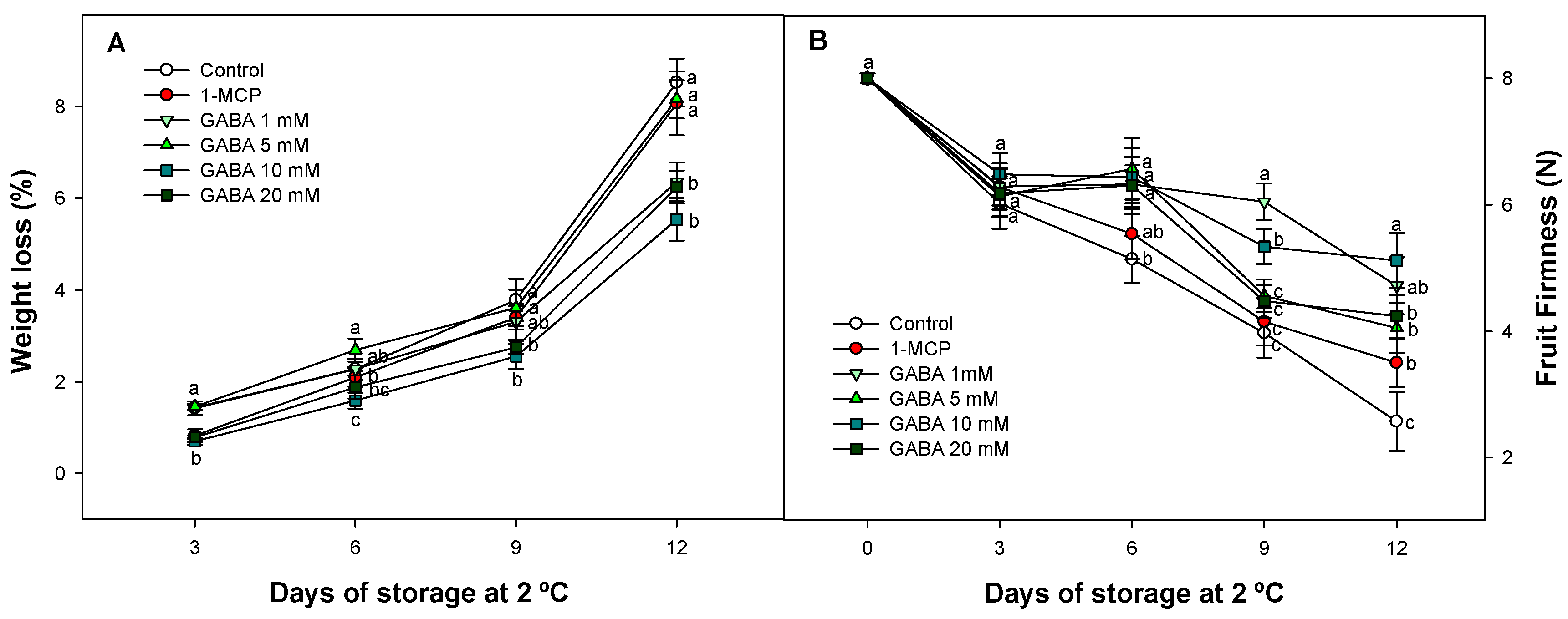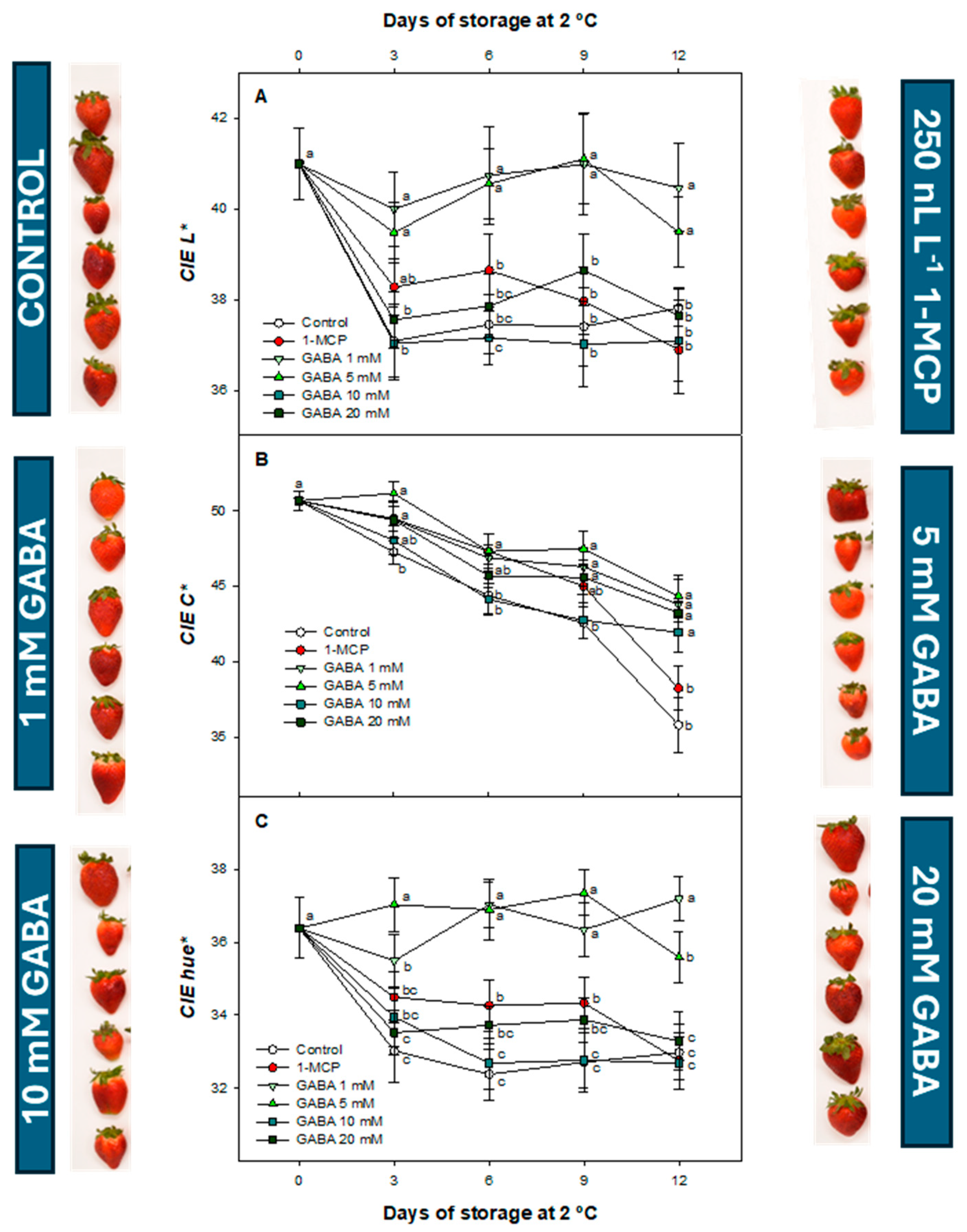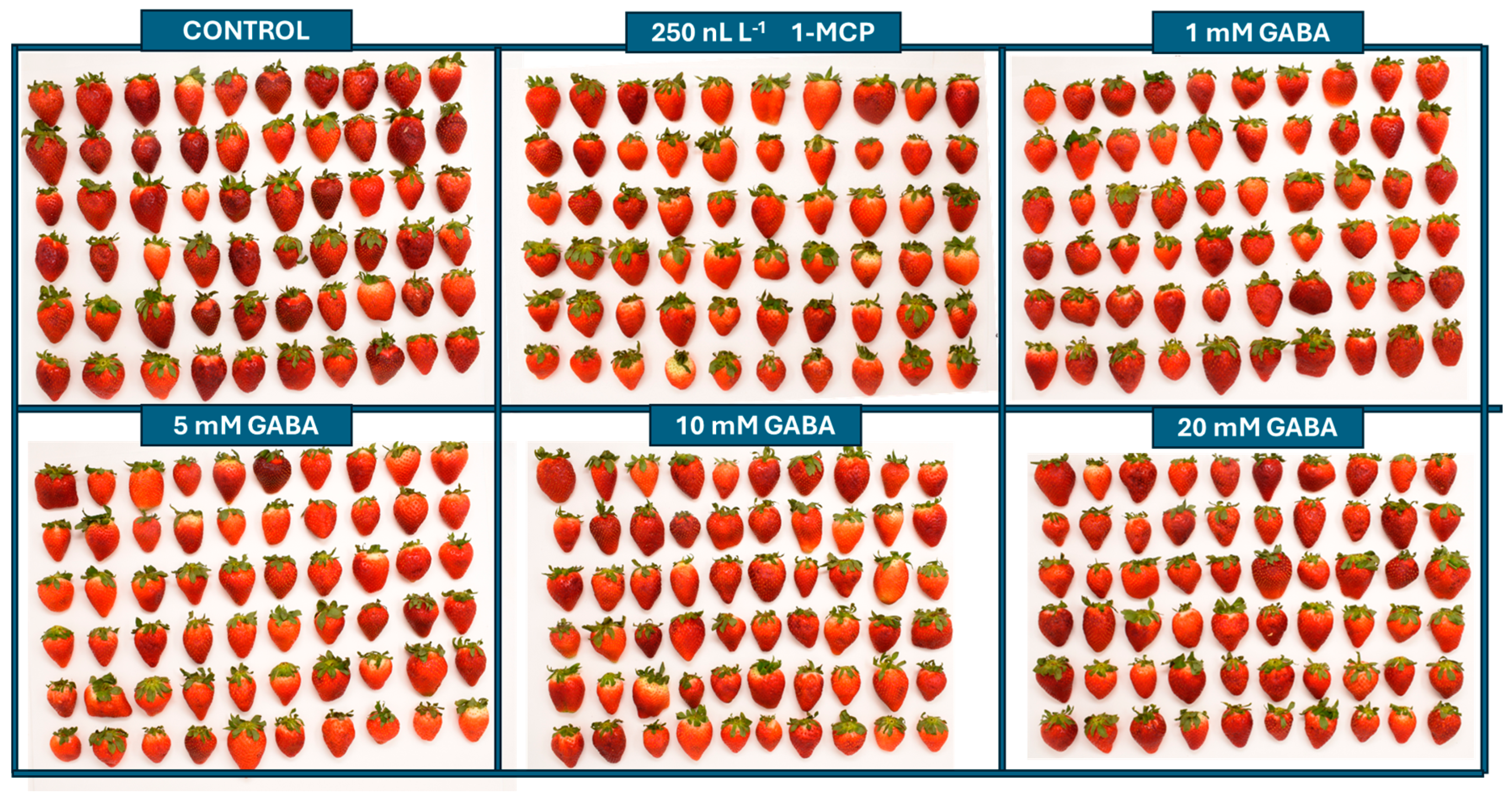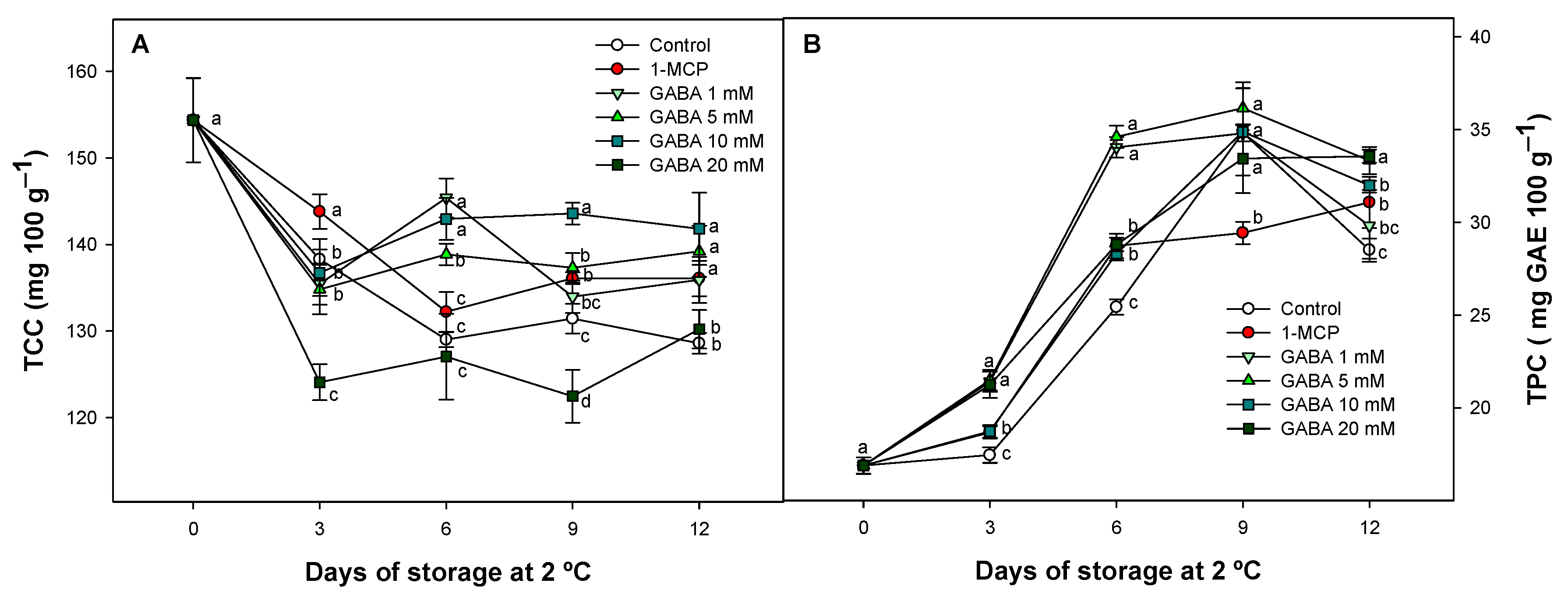Comparative Effect of GABA and 1-MCP in Maintaining Strawberry Fruit Quality During Cold Storage
Abstract
1. Introduction
2. Materials and Methods
2.1. Plant Material and Experimental Design
2.2. Postharvest Quality Parameters
2.3. Statistical Analysis
3. Results and Discussion
3.1. Respiration and Ethylene Production
3.2. Weight Loss and Fruit Softening Evolution
3.3. EL and MDA Content
3.4. Colour Parameter Evolution in Strawberry Fruit During Storage
3.5. Effect of 1-MCP and GABA on TCC in Strawberry Calyces and TPC in the Pulp Tissues
3.6. Effect of 1-MCP and GABA on TSS and TA
4. Conclusions
Author Contributions
Funding
Data Availability Statement
Conflicts of Interest
References
- Azam, M.; Ejaz, S.; Naveed Ur Rehman, R.; Khan, M.; Qadri, R. Postharvest Quality Management of Strawberries. In Strawberry—Pre- and Post-Harvest Management Techniques for Higher Fruit Quality; Asao, T., Asaduzzaman, M., Eds.; IntechOpen: London, UK, 2019; p. 22. [Google Scholar]
- Branzanti, E.C. Strawberry; Mundi-Prensa: Madrid, Spain, 1989. [Google Scholar]
- Wang, L.; Luo, Z.; Yang, M.; Liang, Z.; Qi, M.; Dong, Y.; Xu, Y.; Lin, X.; Li, L. The Action of RED Light: Specific Elevation of Pelargonidin-Based Anthocyanin through ABA-Related Pathway in Strawberry. Postharvest Biol. Technol. 2022, 186, 111835. [Google Scholar] [CrossRef]
- Zhang, Y.; Lin, B.; Tang, G.; Chen, Y.; Deng, M.; Lin, Y.; Li, M.; He, W.; Wang, Y.; Zhang, Y.; et al. Application of γ-Aminobutyric Acid Improves the Postharvest Marketability of Strawberry by Maintaining Fruit Quality and Enhancing Antioxidant System. Food Chem. X 2024, 21, 101252. [Google Scholar] [CrossRef] [PubMed]
- Kader, A.; Rolle, R. Value of Horticultural Perishable and Their Post-Harvest Losses. In The Role of Post-Harvest Managements in Assuring the Quality and Safety of Horticultural Produce; Food and Agriculture Organization of the United Nations: Rome, Italy, 2004; Available online: https://www.fao.org/3/y5431e/y5431e00.htm (accessed on 1 December 2024).
- González, M.D.C.M. Effect of Edible Coatings with Chitosan Nanoparticles and/or Propolis on the Quality and Antioxidant Capacity of Strawberries Fragaria x ananassa. Master’s Thesis, Universidad Autónoma del Estado de Morelos, Cuernavaca, Mexico, 2019. Available online: http://riaa.uaem.mx/handle/20.500.12055/993 (accessed on 1 December 2024).
- Ruiz, M.; Ávila, J.; Ruales, J. Design of a Bioactive Edible Coating for Application on Strawberries (Fragaria vesca) as a Post-Harvest Process. Iberoam. J. Postharvest Technol. 2016, 17, 276–287. [Google Scholar]
- Salazar-Orbea, G.L.; García-Villalba, R.; Bernal, M.J.; Hernández, A.; Tomás-Barberán, F.A.; Sánchez-Siles, L.M. Stability of Phenolic Compounds in Apple and Strawberry: Effect of Different Processing Techniques in Industrial Set Up. Food Chem. 2023, 401, 134099. [Google Scholar] [CrossRef]
- Taban, A.; Haghighi, T.M.; Mousavi, S.S.; Sadeghi, H. Are Edible Coatings (with or without Essential Oil/Extract) Game Changers for Maintaining the Postharvest Quality of Strawberries? A Meta-Analysis. Postharvest Biol. Technol. 2024, 216, 113082. [Google Scholar] [CrossRef]
- Watkins, C.B. Ethylene Synthesis, Mode of Action, Consequences and Control. In Fruit Quality and Its Biological Basis; Knee, M., Ed.; Sheffield Academic Press: Boca Raton, FL, USA, 2002; pp. 180–224. [Google Scholar]
- Watkins, C.B. The Use of 1-Methylcyclopropene (1-MCP) on Fruits and Vegetables. Biotechnol. Adv. 2006, 24, 389–409. [Google Scholar] [CrossRef]
- Liu, R.; Ji, N.; Zhang, N.; Wang, R.; Li, Y.; Lei, J.; Zhou, R. Postharvest Quality Exploration of “Crystal” Grapes in Karst Mountainous Area: Regulatory Effect of High Concentration 1-MCP Fumigation. Agronomy 2023, 13, 2450. [Google Scholar] [CrossRef]
- Qin, Z.; Pan, J.; Li, J.; Sun, J.; Khoo, H.E.; Dong, X. Effects of 1-Methylcyclopropene and Abscisic Acid Treatments on Texture Properties and Microstructures of Postharvest Tangerine (Citrus reticulata cv. Orah). J. Food Process. Preserv. 2022, 46, e16633. [Google Scholar] [CrossRef]
- Jiang, Y.; Joyce, D.C.; Terry, L.A. 1-Methylcyclopropene treatment affects strawberry fruit decay. Postharvest Biol. Technol. 2001, 23, 227–232. [Google Scholar] [CrossRef]
- Langer, S.E.; Marina, M.; Francese, P.; Civello, P.M.; Martínez, G.A.; Villarreal, N.M. New Insights into the Cell Wall Preservation by 1-Methylcyclopropene Treatment in Harvest-Ripe Strawberry Fruit. Sci. Hortic. 2022, 299, 111032. [Google Scholar] [CrossRef]
- Rabiei, V.; Kakavand, F.; Zaare-Nahandi, F.; Razavi, F.; Aghdam, M.S. Nitric Oxide and γ-Aminobutyric Acid Treatments Delay Senescence of Cornelian Cherry Fruits During Postharvest Cold Storage by Enhancing Antioxidant System Activity. Sci. Hortic. 2019, 243, 268–273. [Google Scholar] [CrossRef]
- Li, J.; Zhou, X.; Wei, B.; Cheng, S.; Zhou, Q.; Ji, S. GABA Application Improves the Mitochondrial Antioxidant System and Reduces Peel Browning in ‘Nanguo’ Pears After Removal from Cold Storage. Food Chem. 2019, 297, 124903. [Google Scholar] [CrossRef]
- Cheng, P.; Yue, Q.; Zhang, Y.; Zhao, S.; Khan, A.; Yang, X.; He, J.; Wang, S.; Shen, W.; Qian, Q.; et al. Application of γ-Aminobutyric Acid (GABA) Improves Fruit Quality and Rootstock Drought Tolerance in Apple. J. Plant Physiol. 2023, 280, 153890. [Google Scholar] [CrossRef] [PubMed]
- Saeedi, M.; Mirdehghan, S.H.; Nazoori, F.; Esmaeilizadeh, M.; Saba, M.K. Impact of Calcium and γ-Aminobutyric Acid (GABA) on Qualitative Attributes and Shelf-Life Characteristics of Fresh In-Hull Pistachio During Cold Storage. Postharvest Biol. Technol. 2022, 187, 111863. [Google Scholar] [CrossRef]
- Soleimani Aghdam, M.; Jannatizadeh, A.; Luo, Z.; Paliyath, G. Ensuring Sufficient Intracellular ATP Supply and Friendly Extracellular ATP Signaling Attenuates Stresses, Delays Senescence, and Maintains Quality in Horticultural Crops During Postharvest Life. Trends Food Sci. Technol. 2018, 76, 67–81. [Google Scholar] [CrossRef]
- Soleimani Aghdam, M.; Naderi, R.; Jannatizadeh, A.; Babalar, M.; Sarcheshmeh, M.A.A.; Faradonbe, M.Z. Impact of Exogenous GABA Treatments on Endogenous GABA Metabolism in Anthurium Cut Flowers in Response to Postharvest Chilling Temperature. Plant Physiol. Biochem. 2016, 106, 11–15. [Google Scholar] [CrossRef]
- Zheng, Y.; Han, X.; Zhang, Y.; Qiu, W.; Tao, T.; Xu, Y.; Li, M.; Xie, X.; Sun, P.; Zheng, G.; et al. Preharvest and Postharvest γ-Aminobutyric Acid Treatment Enhance Quality and Shelf Life in Strawberry (Fragaria × ananassa) Fruits. J. Plant Growth Regul. 2025; in press. [Google Scholar] [CrossRef]
- Vu, H.T.; Scarlett, C.J.; Vuong, Q.V. Changes of Phytochemicals and Antioxidant Capacity of Banana Peel During the Ripening Process; With and Without Ethylene Treatment. Sci. Hortic. 2019, 253, 255–262. [Google Scholar] [CrossRef]
- Lezoul, N.E.H.; Belkadi, M.; Habibi, F.; Guillén, F. Extraction Processes with Several Solvents on Total Bioactive Compounds in Different Organs of Three Medicinal Plants. Molecules 2020, 25, 4672. [Google Scholar] [CrossRef]
- Hwang, Y.S.; Min, J.H.; Kim, D.Y.; Kim, J.G.; Huber, D.J. Potential Mechanisms Associated with Strawberry Fruit Firmness Increases Mediated by Elevated pCO2. Hortic. Environ. Biotechnol. 2012, 53, 41–48. [Google Scholar] [CrossRef]
- Zhang, M.; Liu, W.; Li, C.; Shao, T.; Jiang, X.; Zhao, H.; Ai, W. Postharvest Hot Water Dipping and Hot Water Forced Convection Treatments Alleviate Chilling Injury for Zucchini Fruit During Cold Storage. Sci. Hortic. 2019, 249, 219–227. [Google Scholar] [CrossRef]
- Villarreal, N.M.; Marina, M.; Nardi, C.F.; Civello, P.M.; Martínez, G.A. Novel Insights of Ethylene Role in Strawberry Cell Wall Metabolism. Plant Sci. 2016, 252, 1–11. [Google Scholar] [CrossRef] [PubMed]
- Merchante, C.; Vallarino, J.G.; Aragüez, I.; Villarreal, N.; Ariza, M.T.; Martínez, G.A.; Medina-Escobar, N.; Civello, M.P.; Fernie, A.R.; Botella, M.A.; et al. Ethylene is involved in strawberry fruit ripening in an organ-specific manner. J. Exp. Bot. 2013, 64, 4421–4439. [Google Scholar] [CrossRef] [PubMed]
- Villarreal, N.M.; Bustamante, C.A.; Civello, P.M.; Martínez, G.A. Effect of Ethylene and 1-MCP Treatments on Strawberry Fruit Ripening. J. Sci. Food Agric. 2010, 90, 683–689. [Google Scholar] [CrossRef] [PubMed]
- Ansari, M.I.; Jalil, S.U.; Ansari, S.A.; Hasanuzzaman, M. GABA Shunt: A Key-Player in Mitigation of ROS During Stress. Plant Growth Regul. 2021, 94, 131–149. [Google Scholar] [CrossRef]
- Qadir, A.; Hewett, E.W.; Long, P.G. Ethylene Production by Botrytis cinerea. Postharvest Biol. Technol. 1997, 11, 85–91. [Google Scholar] [CrossRef]
- Farida, F.; Hamdani, J.S.; Mubarok, S.; Akutsu, M.; Noviyanti, K.; Nur Rahmat, B.P. Variability of Strawberry Fruit Quality and Shelf Life with Different Edible Coatings. Horticulturae 2023, 9, 741. [Google Scholar] [CrossRef]
- Badiche-El Hilali, F.; Valverde, J.M.; Díaz-Mula, H.; Serrano, M.; Valero, D.; Castillo, S. Potential Preharvest Application of γ-Aminobutyric Acid (GABA) on Improving Quality of ‘Verna’ Lemon at Harvest and During Storage. Agriculture 2023, 13, 1397. [Google Scholar] [CrossRef]
- Chen, H.; Wang, H.; Jiang, X.; Chen, C.; Cheng, Y. Effects of γ-Aminobutyric Acid Treatment on the Quality Properties and Chilling Tolerance of Guava Fruit During Cold Storage. Food Ferment. Ind. 2021, 47, 130–136. [Google Scholar] [CrossRef]
- Ruiz-Aracil, M.C.; Valverde, J.M.; Ilea, M.I.M.; Valero, D.; Castillo, S.; Guillén, F. Innovative Postharvest Management for Hass Avocado at the Preclimacteric Stage: A Combined Technology with GABA and 1-MCP. Foods 2024, 13, 2485. [Google Scholar] [CrossRef]
- Tian, M.S.; Prakash, S.; Elgar, H.J.; Young, H.; Burmeister, D.M.; Ross, G.S. Responses of Strawberry Fruit to 1–MCP and Ethylene. Plant Growth Regul. 2000, 32, 83–90. [Google Scholar] [CrossRef]
- Medina-Santamarina, J.; Serrano, M.; Ruiz-Aracil, M.C.; Ilea, M.I.M.; Martínez-Romero, D.; Guillén, F. A Synergistic Effect Based on the Combination of Melatonin with 1-Methylcyclopropene as a New Strategy to Increase Chilling Tolerance and General Quality in Zucchini Fruit. Foods 2022, 11, 2784. [Google Scholar] [CrossRef] [PubMed]
- Nie, X.; Zhao, Y.; Li, Y.; Lv, H. 1-Methylcyclopropylene and Heat Treatment Alleviate Chilling Injury in Purple Sweet Potato by Regulating ROS Homeostasis. Sci. Hortic. 2024, 324, 112606. [Google Scholar] [CrossRef]
- Martínez-González, M.d.C.; Bautista-Baños, S.; Correa-Pacheco, Z.N.; Corona-Rangel, M.L.; Ventura-Aguilar, R.I.; Del Río-García, J.C.; Ramos-García, M.d.L. Effect of Nanostructured Chitosan/Propolis Coatings on the Quality and Antioxidant Capacity of Strawberries During Storage. Coatings 2020, 10, 90. [Google Scholar] [CrossRef]
- Soleimani Aghdam, M.; Fard, J.R. Melatonin Treatment Attenuates Postharvest Decay and Maintains Nutritional Quality of Strawberry Fruits (Fragaria × ananassa cv. Selva) by Enhancing GABA Shunt Activity. Food Chem. 2017, 221, 1650–1657. [Google Scholar] [CrossRef] [PubMed]
- Nazoori, F.; ZamaniBahramabadi, E.; Mirdehghan, S.H.; Rafie, A. Extending the shelf life of pomegranate (Punica granatum L.) by GABA coating application. J. Food Meas. Charact. 2020, 14, 2760–2772. [Google Scholar] [CrossRef]
- Babarabie, M.; Zarei, H.; Eskandari, A. The impact of pre-harvest treatment with gamma-aminobutyric acid (GABA) and salicylic acid on vase life and post-harvest traits of tuberose cut flowers. Acta Sci. Pol. Hortorum Cultus 2019, 18, 83–92. [Google Scholar] [CrossRef]
- Nguyen, V.T.B.; Nguyen, D.H.H.; Nguyen, H.V.H. Combination effects of calcium chloride and nano-chitosan on the postharvest quality of strawberry (Fragaria x ananassa Duch.). Postharvest Biol. Technol. 2020, 162, 111103. [Google Scholar] [CrossRef]
- Yu, W.; Zhang, X.; Yan, W.; Sun, X.; Wang, Y.; Jia, X. Effects of 1-methylcyclopropene on skin greasiness and quality of ‘Yuluxiang’ pear during storage at 20 °C. J. Integr. Agric. 2024, 23, 2476–2490. [Google Scholar] [CrossRef]
- Aghdam, M.S.; Flaherty, E.J.; Shelp, B.J. γ-Aminobutyrate improves the postharvest marketability of horticultural commodities: Advances and prospects. Front. Plant Sci. 2022, 13, 884572. [Google Scholar] [CrossRef]
- Yang, X.; Yan, R.; Chen, Q.; Fu, M. Analysis of flavor and taste attributes differences treated by chemical preservatives: A case study in strawberry fruits treated by 1-methylcyclopropene and chlorine dioxide. J. Food Sci. Technol. 2020, 57, 4371–4382. [Google Scholar] [CrossRef] [PubMed]
- Selvarajah, S.; Bauchot, A.D.; John, P. Internal browning in cold-stored pineapples is suppressed by a postharvest application of 1-methylcyclopropene. Postharvest Biol. Technol. 2001, 23, 167–170. [Google Scholar] [CrossRef]







Disclaimer/Publisher’s Note: The statements, opinions and data contained in all publications are solely those of the individual author(s) and contributor(s) and not of MDPI and/or the editor(s). MDPI and/or the editor(s) disclaim responsibility for any injury to people or property resulting from any ideas, methods, instructions or products referred to in the content. |
© 2025 by the authors. Licensee MDPI, Basel, Switzerland. This article is an open access article distributed under the terms and conditions of the Creative Commons Attribution (CC BY) license (https://creativecommons.org/licenses/by/4.0/).
Share and Cite
Ilea, M.I.M.; Díaz-Mula, H.M.; García-Molina, A.; Ruiz-Aracil, M.C.; Fernández-Picazo, C.; Guillén, F. Comparative Effect of GABA and 1-MCP in Maintaining Strawberry Fruit Quality During Cold Storage. Horticulturae 2025, 11, 370. https://doi.org/10.3390/horticulturae11040370
Ilea MIM, Díaz-Mula HM, García-Molina A, Ruiz-Aracil MC, Fernández-Picazo C, Guillén F. Comparative Effect of GABA and 1-MCP in Maintaining Strawberry Fruit Quality During Cold Storage. Horticulturae. 2025; 11(4):370. https://doi.org/10.3390/horticulturae11040370
Chicago/Turabian StyleIlea, Mihaela Iasmina Madalina, Huertas María Díaz-Mula, Alba García-Molina, María Celeste Ruiz-Aracil, Christian Fernández-Picazo, and Fabián Guillén. 2025. "Comparative Effect of GABA and 1-MCP in Maintaining Strawberry Fruit Quality During Cold Storage" Horticulturae 11, no. 4: 370. https://doi.org/10.3390/horticulturae11040370
APA StyleIlea, M. I. M., Díaz-Mula, H. M., García-Molina, A., Ruiz-Aracil, M. C., Fernández-Picazo, C., & Guillén, F. (2025). Comparative Effect of GABA and 1-MCP in Maintaining Strawberry Fruit Quality During Cold Storage. Horticulturae, 11(4), 370. https://doi.org/10.3390/horticulturae11040370








